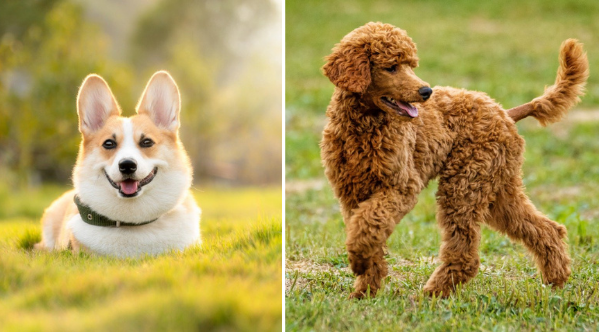Gentle Guides for Your Childs First Corgi Interaction

Hey there! So, your child is about to have their first corgi interaction, huh? Exciting times ahead! But before you jump right into it, let's make sure we cover all the bases and ensure a safe and enjoyable experience for everyone involved.
Think of this guide as your trusty compass, guiding you through the wonderful world of corgis. We'll explore everything from understanding corgi temperament to teaching your child proper corgi etiquette. And don't worry, we'll be right there to supervise and make sure everything goes smoothly.
By following these gentle guides, you'll create a strong foundation for a positive bond between your child and their new furry friend. So, let's get started on this adventure together and make your child's first corgi interaction one they'll cherish forever!
Understanding Corgi Temperament
To understand Corgi temperament, observe their behavior and interactions with other dogs and people. Socialization is key for Corgis. It helps them become comfortable and well-behaved around other animals and humans. Early socialization is especially important to prevent any potential behavioral issues. Introduce your Corgi to various environments, sounds, and situations. Take them to parks, meet other dogs, and expose them to different people.
Positive reinforcement is a highly effective training technique for Corgis. Reward them with treats, praise, and affection when they behave well. Consistency is also crucial in their training. Establish clear boundaries and stick to them. Corgis are intelligent and eager to please, so they respond well to positive, reward-based training methods.
Preparing Your Child for the Interaction
Now that you're getting ready for your child's first corgi interaction, it's important to prepare them for what to expect.
One key aspect is calming any anxieties or fears they may have. By reassuring them that the corgi is friendly and gentle, you can help alleviate any worries they may have.
Additionally, teaching them how to pet the corgi gently and properly will ensure a positive and safe interaction for both your child and the corgi.
Calming Anxieties and Fears
Ease your child's anxieties and fears by gradually introducing them to the idea of interacting with a Corgi. Understanding anxiety triggers is crucial in helping your child feel more at ease. Some common triggers include unfamiliar environments or animals, loud noises, and previous negative experiences.
To address these triggers, start by discussing Corgis with your child and showing them pictures or videos. This will help familiarize them with the breed and reduce any fear of the unknown.
Next, visit a friend or family member who owns a Corgi, allowing your child to observe from a distance. As they become more comfortable, encourage them to interact with the Corgi under your supervision.
Teach your child calming techniques such as deep breathing and positive self-talk to help manage any anxiety they may feel. Remember, patience and gradual exposure are key in calming your child's fears.
Teaching Gentle Petting
Start by introducing your child to the concept of gentle petting as they prepare to interact with a Corgi. It's important for them to understand that animals have feelings too, and that being gentle is the key to a positive interaction. Teaching patience is crucial, as your child needs to understand that they should never rush or force their interaction with the Corgi.
Here are a few tips to help you establish boundaries and teach gentle petting:
- Show them how to approach the Corgi slowly and calmly.
- Demonstrate how to use soft strokes and avoid pulling or tugging on the fur.
- Teach them to listen and watch for cues from the Corgi, such as wagging tail or relaxed body language.
Introducing Your Child to Corgi Basics
So, you're ready to introduce your child to the wonderful world of corgis!
Before diving into the fun, it's important to cover the basics.
First, you'll want to teach your child about corgi behavior and safety, ensuring they know how to approach and interact with these adorable pups.
Next, focus on building trust and familiarity between your child and the corgi, helping them develop a strong bond.
Lastly, get ready for some fun activities with corgis, like playing fetch or going for walks, to make the experience even more enjoyable for your child.
Corgi Behavior and Safety
Ensure your child's safety by understanding Corgi behavior and introducing them to the basics. Corgis are known for their intelligence and playfulness, but like any dog, they require proper training and socialization.
Here are a few important things to keep in mind:
- Positive Reinforcement: Use treats and praise to reward good behavior during corgi training. This will help them associate positive experiences with learning commands and following instructions.
- Early Socialization: Introduce your child and corgi to new people, animals, and environments from an early age. This will help your corgi develop good social skills and become comfortable in various situations.
- Body Language: Teach your child to recognize signs of aggression or fear in a corgi, such as growling, baring teeth, or a stiff body. Encourage your child to give the corgi space if they display these behaviors.
Building Trust and Familiarity
Introduce your child to the basics of interacting with a corgi to build trust and familiarity. Building trust is essential when it comes to establishing a rapport between your child and the corgi.
Start by teaching your child to approach the corgi calmly and slowly. Encourage them to speak softly and avoid sudden movements. Show them how to gently pet the corgi, avoiding sensitive areas like the face or tail. Remind them to always ask for permission before touching the corgi.
Teach your child to respect the corgi's boundaries and signals. Help them understand that if the corgi shows signs of discomfort or stress, they should give it some space.
Fun Activities With Corgis
As you continue to build trust and familiarity with your child's corgi, it's time to explore some fun activities that will introduce your child to the basics of interacting with these adorable dogs. Here are a few ideas to get you started:
- Fun Training Exercises: Engage your child in simple training exercises that won't only strengthen their bond with the corgi but also teach them important commands. Start with basic commands like sit, stay, and come. Make it a game and reward both your child and the corgi with treats or praise when they get it right.
- Corgi Themed Crafts: Get creative and have fun with corgi-themed crafts. Your child can make a personalized dog collar or leash, design a corgi-inspired art piece, or even create a corgi-themed scrapbook. This not only encourages creativity but also helps your child express their love for their furry friend.
- Obstacle Course Fun: Set up a mini obstacle course in your backyard or living room using household items like pillows, hula hoops, and tunnels. Guide your child and the corgi through the course, teaching them agility and coordination while having a blast.
These activities won't only make your child's interaction with their corgi more enjoyable but also lay the foundation for responsible pet ownership and a lifelong love for dogs. Have fun, stay safe, and enjoy the wonderful world of corgis!
Teaching Proper Corgi Etiquette to Your Child
Teach your child proper Corgi etiquette by setting clear guidelines for interacting with the dog. It's important to teach your child how to handle a Corgi safely and respectfully. Start by explaining to them that Corgis are small dogs and may be more fragile than they appear.
Show them how to approach the dog calmly and gently, avoiding sudden movements. Teach them to always ask permission before petting the Corgi, as not all dogs may be comfortable with strangers. Encourage your child to pet the dog gently, avoiding rough play or pulling on their fur.
Setting boundaries with Corgis is crucial, so make sure your child understands not to bother the dog when they're eating or sleeping.
Supervising the First Interaction
Ensure proper supervision during your child's first interaction with a Corgi. It's important to establish boundaries and keep both your child and the Corgi safe. Here are some tips to help you supervise the interaction effectively:
- Be present: Stay close to your child and the Corgi at all times. This way, you can intervene if any issues arise.
- Watch body language: Pay attention to both your child's and the Corgi's body language. Look for signs of fear, aggression, or discomfort, and step in if necessary.
- Set limits: Teach your child to respect the Corgi's personal space and not to pull on their ears or tail. Encourage gentle petting and praise good behavior.
Ensuring Safety Measures During the Encounter
Stay vigilant and prioritize safety during your child's first encounter with a Corgi by implementing necessary precautions.
When it comes to interacting with any dog, it's crucial to establish boundaries and create a calm environment. Start by teaching your child to approach the Corgi slowly and gently, allowing the dog to sniff their hand before attempting to pet them.
Remind your child to avoid sudden movements or loud noises that may startle the Corgi. Additionally, supervise the interaction closely to ensure both the child and the dog are comfortable and safe.
If at any point the Corgi shows signs of discomfort or aggression, calmly and quickly remove your child from the situation.
Encouraging Positive Bonding Between Child and Corgi
To foster a strong bond between your child and the Corgi, encourage regular and supervised interactions. Positive reinforcement plays a crucial role in building trust and creating a positive association between your child and the Corgi. Here are some ways to encourage positive bonding:
- Reward good behavior: Use treats and praise to reinforce positive behavior from both your child and the Corgi.
- Establish boundaries: Teach your child to respect the Corgi's personal space and to approach with caution. This will help create a safe and comfortable environment for both parties.
- Engage in interactive play: Encourage your child to play games like fetch or hide-and-seek with the Corgi. This won't only strengthen their bond but also provide mental stimulation for the dog.











